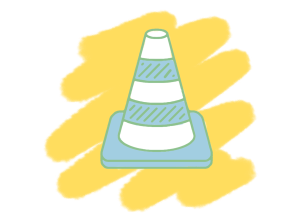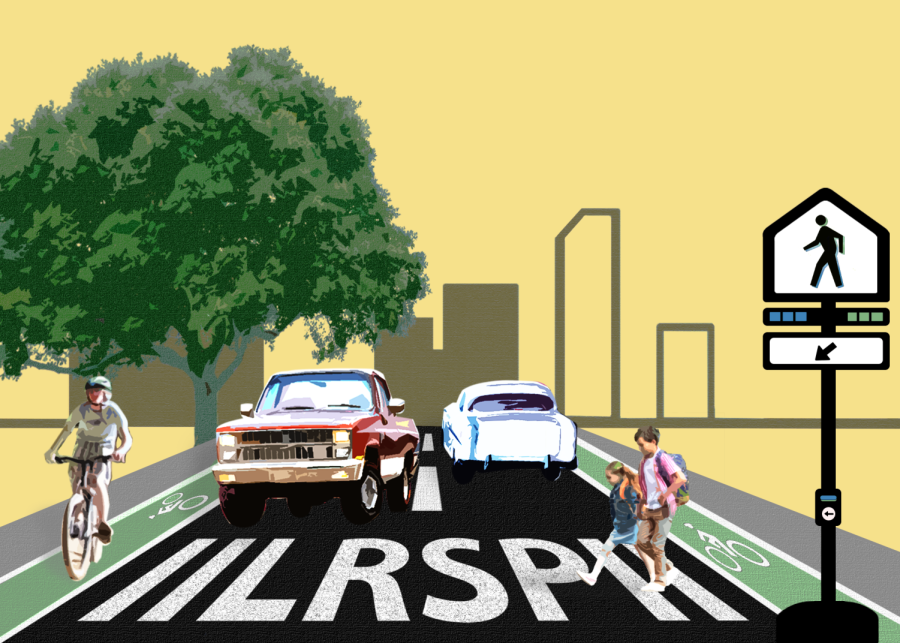Graphic by Kalyani Puthenpurayil
The Local Road Safety Plan targets to reduce fatalities and severe injuries for all types of commuters, including bikers, drivers and pedestrians.
Paving the way for safer roads
Exploring how Cupertino is working towards creating a Local Road Safety Plan
May 22, 2022
With a vision to decrease the fatalities and severe injuries on roads, the Cupertino City staff has been tackling local road safety through the Local Road Safety Plan. The LRSP is currently in its development stage and involves various essential stakeholders including FUHSD, the County Sheriff Department and the Bicycle and Pedestrian Committee.
The plan
According to City of Cupertino Transportation Manager David Stillman, the LRSP will help decrease the amount of road accidents in Cupertino through creating “a document that identifies safety improvements for various locations throughout the city that are based upon the crashes that have occurred,” which will then help gain grants from the Highway Safety Improvement Program and “apply [that] funding in the future [to] enhance the safety of travel throughout Cupertino.”
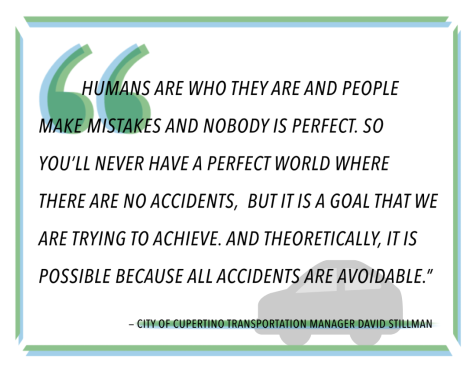
To attain these goals, the members of LRSP plan to assess both engineering and non-engineering strategies in order to improve safety in different ways. They hope to do so with the “4 E’s of Traffic Safety,” which are education, enforcement, engineering and emergency medical services. These strategies target both educating drivers on road safety and changing infrastructure.
“Humans are who they are and people make mistakes and nobody’s perfect,” Stillman said. “So you’ll never have a perfect world where there are no accidents, but it is a goal that we try to achieve. And theoretically, it is possible because all accidents are avoidable.”
The community meeting
Several concerns about road safety were raised at the LRSP meeting on March 30. At the meeting, Walk-Bike Cupertino founder Larry Dean commended the project for taking initiative to develop better roads while also voicing some of his worries. He notices how most “great roads attract traffic,” which he views as a major problem for road safety, explaining that as in-person work becomes more widespread, more people will commute through Cupertino. In order to combat the potential dangers increased traffic will cause, Dean emphasizes the importance of constructing methods for speed dampening, such as speed bumps and speed limit signs, throughout the city.
He also believes that right turn on red should be “[eliminated] throughout the city” because of the dangers it poses to pedestrians and bikers.
“It’s hard to keep your eye on all the traffic and the pedestrians attempting to safely cross those intersections,” Dean said during the meeting. “I think that that’s a huge issue on that side. If you take a look at the pedestrians, every time that you’re stopped and waiting for them to cross an intersection you can see they have the fear of God in their eyes — being concerned about getting hit, and that’s a very legitimate thing for them to be thinking.”
Cupertino resident Lisa Warren also expressed her concerns on pedestrian safety, bringing up a crossing light that hasn’t been functioning at the Finch Avenue and Stevens Creek Boulevard intersection. Warren mentions how the non-functioning signals make the intersection “very dangerous,” especially for students who walk and bike across the intersection in order to get to school and suggests that signs be put out to notify people of the change made.
“Other cities will put out signs letting people know that traffic movement has changed — there’s a change to it and people aren’t just suddenly faced with this new situation that they can’t figure out,” Warren said. “So I would suggest when such major changes [are made], that there’ll be some kind of warning like other cities do. If it’s taken this long to figure out the best way to operate something at Wolfe and Stevens Creek, it seems like there should be some effort to educate people on how it’s supposed to work.”
Cupertino resident John Zhou suggested handing out flyers to cars waiting at intersections as a way to educate the community about the LRSP. Zhou also brings up the concern of unprotected left turns — intersections where a left turn is allowed but there is no left turn signal — in some parts of the city and inquires whether the project is conducting targeted outreach for specific demographics, such as seniors, to make sure the new changes will accommodate their needs.
Cupertino resident and Walk-Bike Cupertino member Jennifer Shearin also emphasizes the need for targeted outreach, but to a different group of people — students. She notes that organizations such as Safe Routes to School are working on educating students who bike and walk to school on the safest routes they could take. However, in order to create viable solutions, a holistic view of all types of commuters and their needs must be taken into consideration, especially of students who use roads to get to school regularly. This includes adding protected bike lanes which would allow for more safety when biking, but it can also cause traffic due to slow car movement. Shearin is also concerned because only about 25% of all accidents are actually reported, so the LRSP data is very limited.
“All modes of transport are important, so we need to make sure that we are not considering only car traffic and nothing else,” Shearin said. “At our local schools, which [are] Cupertino and Monta Vista, [I’ve been] bringing maps to [students] to have [them] point out where they’ve had near misses or where they’ve had accidents or where they find trouble, because I think that students tend to be an underserved population as far as being heard. [A lot of the time] they’re the ones on bikes, because [many] don’t have [a] driver’s license. I just want to make sure that we are all in this together. It’s not cars versus bikes, it’s every mode of transport.”
The outreach involving students
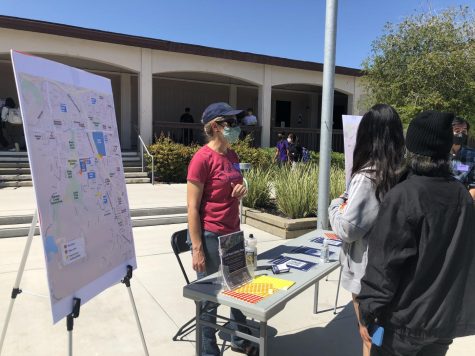
On April 1, 2022, the City of Cupertino came to Monta Vista and set up a booth during lunch to inform students about the Local Road Safety Plan, Safe Routes to School and Via, a public transport company, all which have partnered with the City of Cupertino to encourage cleaner modes of transportation.
Birgit Werner, who works for the city and is a member of the Safe Routes to School team, stood by a table that contained information about the LRSP and handed out yellow, orange and red stickers to students to place on maps to express their varying concerns. Yellow was for areas with concern, orange was for areas where students had near misses and red was areas where students witnessed accidents.
There is also an online version of these maps where individuals can drop pins and write a short comment on what the incident was. The information gathered from both the sticker map and its online version will go to the city traffic engineers, who will then evaluate the information.
“If there’s a corner that gets a whole bunch of stickers or drop pins, they’ll go out and watch that corner and figure out what was so bad about it,” Werner said. “They’ll take all that information and figure out what they can do to make it better.”
Junior Kelly Tung, one of the two student MVHS representatives of Safe Routes to School describes SR2S as a “city-led organization committed to creating a safer environment for students in Cupertino to travel to and from school.” The organization has created and shared maps to allow them to navigate intersections, bike routes and crosswalks safely.
Tung attends monthly group meetings for SR2S in which members discuss topics related to bike and pedestrian safety such as Cupertino’s infrastructure. Anyone within the community can join to express their thoughts and suggestions on how SR2S could improve these elements.
“Safety is definitely a concern that parents hold,” Tung said. “A few years ago, there was an accident [at] the intersection near 7-Eleven where a biker was killed by a big truck. I think that specific event made Monta Vista parents wary of [allowing] their kids [to bike] to school and I wish we could incorporate more safe trails. Cupertino [is doing] its part in trying to make our roads safer; for example, they incorporated a [protected bike] lane down McClellan.”
Ultimately, Tung and Werner want to encourage biking and walking and promote change throughout the city to make roads safer for everyone.
“It’s a beautiful sunny day,” Werner said. “Walk and bike to school, take Via, take the bus. It’s gorgeous. Leave the stinky car at home.”
The research process
The LRSP conducts research using data from the past five years, excluding data during the COVID-19 pandemic due to irregularities in travel patterns. The project analyzes various factors such as the locations that accidents took place, the mode of transportation that the people involved used, the type of accident and the times at which they occured. Using this, a plan on how to mitigate these problems can be developed.
Stillman is in charge of managing projects such as constructing bike lanes around the city to resolve concerns surrounding traffic, speed, congestion and other safety related issues for all modes of transport. He examines data on the types of accidents that occur at specific locations to determine the necessary improvements; for instance, if rear-end accidents are common in one area, the LSRP aims to implement speed measures there.
“Once the plan is completed, we’ll have done the research to say [a specific] intersection is our highest accident intersection in the city,” Stillman said. “The federal government would look and say, ‘OK, this is actually a real problem location based upon real data.’ They can use [it] to justify granting us funding to complete the safety improvements.”
While the engineering and education aspects of LRSP mitigate road accidents, the project’s enforcement and emergency services are used when accidents happen. Enforcement involves deputies who monitor traffic and cite drivers who show dangerous behavior on the road and re-educate them on driving laws. Emergency services are resources that are available in the case that accidents occur, used to provide a timely response and minimize injuries.
Corridors with heavy traffic and high accident intersections have been determined through data trends and Stillman hopes that the LRSP team can “start implementing some of the improvements to see if the accidents in those locations go down.”
A change has recently been made on the Homestead Road and De Anza Boulevard intersection where, according to Stillman, the traffic signal poles and their arms are unusually small for a street as large as Homestead. In order to improve visibility, the traffic lights will be replaced.
The stakeholders of LSRP include the city’s Public Works and Planning & Public Outreach Representative departments, the County Sheriff Department, the County Fire Department, Bicycle and Pedestrian Committee, Cupertino Union School District (CUSD), Fremont Union High School District (FUHSD) and Walk-Bike Cupertino. Stillman describes these entities to be “similar to the general public” as in they voice “specific insight into their specific expertise.” For example, CUSD and FUHSD can share concerns relating to students’ modes of transportation.
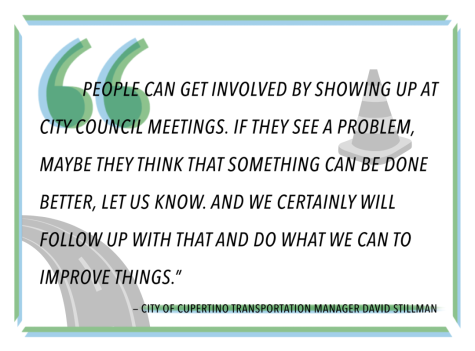
Stillman hopes that the combination of social media, the LRSP website and “word of mouth” as the staff educates community members on the project will help the LRSP gain more perspectives. Both Lindskog and Stillman suggest citizens to get involved on a “city level” to voice their opinions and thoughts about the city’s decisions.
“We have Bicycle Pedestrian Commission meetings every month — the public is welcome to come and discuss things that they have concerns relating to bicycling and walking throughout town and suggest improvements,” Stillman said. “People can get involved by showing up at city council meetings. They can attend our meetings and just provide feedback. If they see a problem, maybe they think that something can be done better, let us know. And we certainly will follow up with that and do what we can to improve things.”
The concerns for students
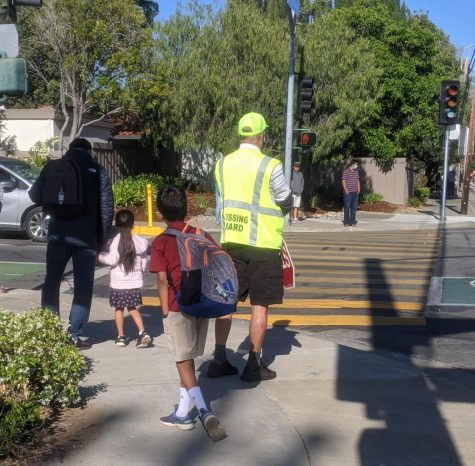
Crossing guard Steven, who did not want to provide his last name, carefully monitors both the traffic signals and the children waiting to cross the road behind him as he prepares to guide them across the road. The safety of students is of utmost importance to Steven, who is stationed at the McClellan Road and Bubb Road intersection. He pays close attention to students in the earlier grades of elementary school who are crossing by themselves.
CUSD Board of Education member Jerry Liu finds that if younger students are walking in groups, they are more likely to notice and alert each other of potential dangers. However, even when students follow the rules and pay attention to the road, close calls and accidents can happen due to drivers’ carelessness. Liu has observed “aggressive behavior at the intersection [between] Orange and McClellan,” both of which are roads that many students take to commute to school.
Liu believes that having crossing guards is essential to ensuring that walkers and bikers reach school safely. CUSD and FUHSD work together to locate key intersections in students’ routes to school and the city council accordingly stations crossing guards at those points. Liu has also noticed that parents have been requesting the placement of more crossing guards, which needs to be looked into due to the City’s limited budget.
“People are more likely to run the flashing light than to run over a crossing guard,” Liu said. “The presence of having a person makes a huge, huge difference. I wish we could do more and that’s why we’re looking to see if we can support more crossing guards.”
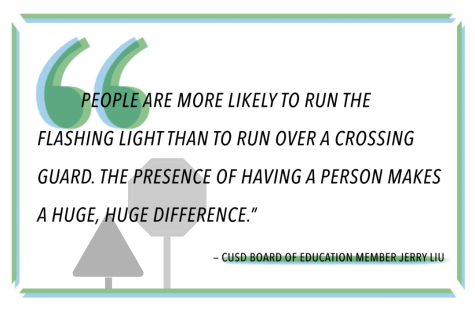
One major issue that Steven faces is drivers turning right on red, despite the “no right turn on red” signs that were implemented at the intersection two or three years ago.
“As I walk back to my corner, I’ll [put] my hand out for cars that are turning right [on red],” Steven said. “Some will continue through [because] they think I’m waving at them, but I’m not. I’m holding my hand to say, ‘Please stop, I’m crossing in front of you.’ But most drivers understand [that] this is a school zone and [that] I’m trying to look out for the kids.”
Sophomore Julianne Tsai, who usually walks on Orange Avenue to get to school and home, is no stranger to road safety issues. Unlike the roads that Steven monitors, there are no bike lanes or sidewalks on Orange Avenue. Orange Avenue is crowded and branches out to various other roads and courts with cars going in multiple directions, increasing the chance of an accident occurring. During the busier hours, when students are commuting to school, the narrow street becomes even narrower when many cars are parked on the side.
One day, while she was walking home, Tsai witnessed a student bike into a car because of the car’s inconsistent braking. The bike collided into the rear of the car and the student fell off, but didn’t sustain any injuries. While preventing road accidents is important to Tsai, she is also skeptical about what improvements could be made since there is no space to add sidewalks or bike lanes on Orange Avenue. However, she believes that educating children on how to safely walk or bike to school is important, especially if their parents aren’t supervising them.
“There’s a lot of things that kids might not know unless they find out the hard way,” Tsai said. “[My parents] told me I should walk on the side that’s opposite to the direction cars are going when there’s no sidewalk and [to look] both ways when crossing.”
Being the parent of two daughters, one who attends MVHS and the other who attends Kennedy Middle School, Liu understands the concerns that other parents have. However, he believes that it is also important for families to learn about the different transportation options available to students, such as traveling with an adult supervisor in groups known as “walking buses.”
“If I felt it was unsafe, I wouldn’t let them walk to school,” Liu said. “There’s certainly room for improvement, [but] we’re very fortunate in the west side of the city. This is not where the heavy traffic is, [which] tends to be towards the middle and the eastern part of the city.”
The city-led organization Safe Routes to School is also working towards providing students with information on the best routes to take to school in terms of safety. Assistant Principal Sydney Fernandez, who is the MVHS staff representative for SR2S, believes the data the organization collects will allow for a “better understanding of the needs of the community, our school [and] our students.”
“It’s really about getting kids safely to school,” Fernandez said. “I think education in terms of how to be biking safely and what route to take [to] avoid busy streets or busy intersections could be helpful.”
The future of LRSP
For Liu, the future of the LRSP is clear. As community input is collected, crucial road segments will be determined through the amount of accidents that have taken place there. After generating a report, the city will then proceed with their goal to gain funding from the state and federal government to be put towards improving road safety in Cupertino. The LRSP will continue to promote walking and biking as an eco-friendly alternative to driving.
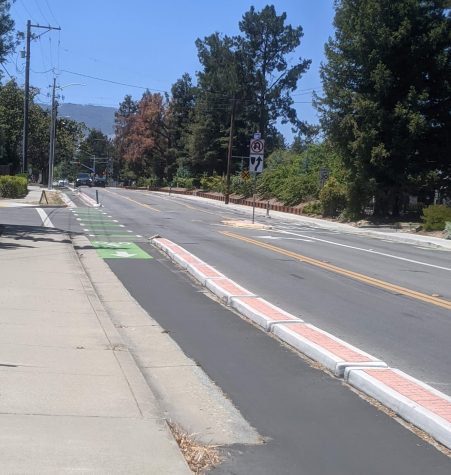
“It’s been a very auto-centric society for a long time,” Stillman said. “There has to be a slow shift in the way everybody thinks about travel. Over time, people [will] start to accept and be willing to make compromises to accommodate other modes. Right now, people don’t want to be slowed down [by] bike lane[s] or some kind of accommodation for bikes. But [if] we keep going in this path, eventually there will be acceptance. And as we’re making bike improvements, [we] don’t completely forget about car[s] because we understand that people still need to commute by car in a lot of cases.”
Cupertino Bicycle Pedestrian Commission member Erik Lindskog also believes that the amount of people who bike and walk needs to increase because driving expends fossil fuels and contributes to global warming. He believes that the city is putting in consistent effort into “building a lot of new bike lanes and bike trails” and suggests other changes that could be implemented.
“There is a lot of will from a lot of people in Cupertino to add more bike infrastructure, [including] infrastructure separated from cars to bring out less experienced bikers,” Lindskog said. “I hope that we get fantastic bike facilities all throughout the Bay Area because we have such a fantastic climate. Our geography is very suitable for biking because it is mostly flat and our distances are not too far. When you add e-bikes into the equation, some distances are a little too long for regular bikes, but with e-bikes, you can easily cover 10 to 15 miles.”

While City Councilmember Hung Wei receives complaints about McClellan Road being congested due to bike lanes, she believes that looking at the big picture, where other modes of transportation are included, is important. She strongly encourages walking and biking in Cupertino and believes that the city needs “to put forward policy in an [environmentally friendly] direction.”
“Policy drives change, so when we do policy we have to think, ‘What policy is environmentally friendly? What policy makes people change their old habits?’” Wei said. “I do hope that people realize the little things you do matter — even if it is inconvenient, it can make a big difference, so we do need to start changing habits, little by little. If we have safe bike routes, people will change their habits and bike instead of drive. It’s that type of change of habit residents can make to go in the right direction.”
